Biometrics: the art of recognition. Prospects for biometric systems on the example of the Id-Me platform from RecFaces
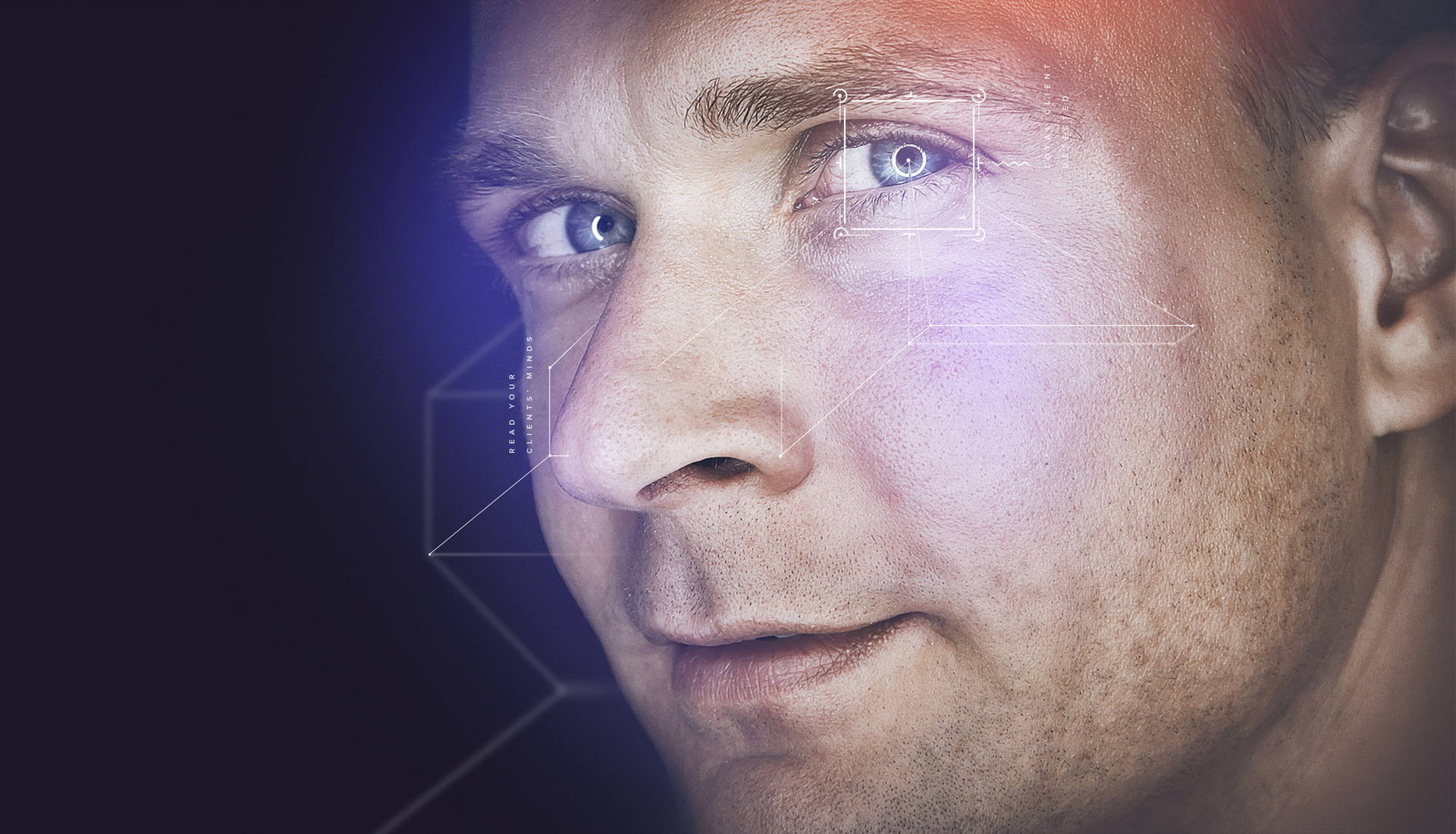
Many readers of Habr, probably, are already familiar with biometric technologies. They are now ubiquitous. In a general sense, biometrics is a system for recognizing people according to one or several physical (or behavioral) characteristics. In the field of information technology, biometric data is used as one of the forms of access identifier management and access control. Typically, the operation of biometric systems is reduced to two main types.
The first is called verification, it is a comparison of the test result with a biometric template. This option helps to check if this is the person for whom he claims to be. Verification can be carried out in various ways, including a smart card, username or its number. The second mode is identification. After receiving a specific sample, the system is checked with a database of biometric data to determine the identity. There is one important point here - for this mode of operation, the biometric sample must be in the database, and the comparison is carried out on a “one with many” basis. In general, biometric technologies have huge potential, which has not yet been fully realized. What is the state of biometric technology in Russia and the world today?
In some cases, their development cannot yet be considered satisfactory. So far, this area is actively developing, although some results are already there (more on this below). In some cases, biometrics is not considered a very reliable way of identification or verification. In the United States, for example, the Tampa City Police Department even uninstalled facial recognition software, considering it not too reliable. But there it was a question of introducing obsolete methods of biometrics, which do not always show their best.
However, modern biometrics technologies are becoming more accurate and reliable. Many companies and scientific organizations are engaged in research and development in this area. Moreover, the priority over time has shifted to non-contact methods of biometric recognition. Biometrics is used in many areas, including banking, security and access control systems, visa control systems, police identification systems for criminals, collecting statistics on visitors and much more. So far, about half of the biometric market is occupied by fingerprint recognition systems. But the situation is gradually changing, developers understand
Biometrics: Scales
In general, we can say that biometrics has become an integral part of people's lives. In some countries, for example, without biometric data, a passport and a visa cannot be obtained. Government organizations in various countries believe that biometrics is one of the most effective ways to identify refugees and those who illegally cross the border.
Now there are many projects based on biometric technologies. Perhaps one of the most ambitious is the AADHAAR project, implemented in India. It is a biometric identification system that contains data from more than a billion people. The database contains about 10 billion fingerprint templates, two billion iris templates and a billion photos. Something similar was shown in the science fiction film “I - the beginning” (I origins). However, identification by iris is a very real technology, which is becoming increasingly popular.
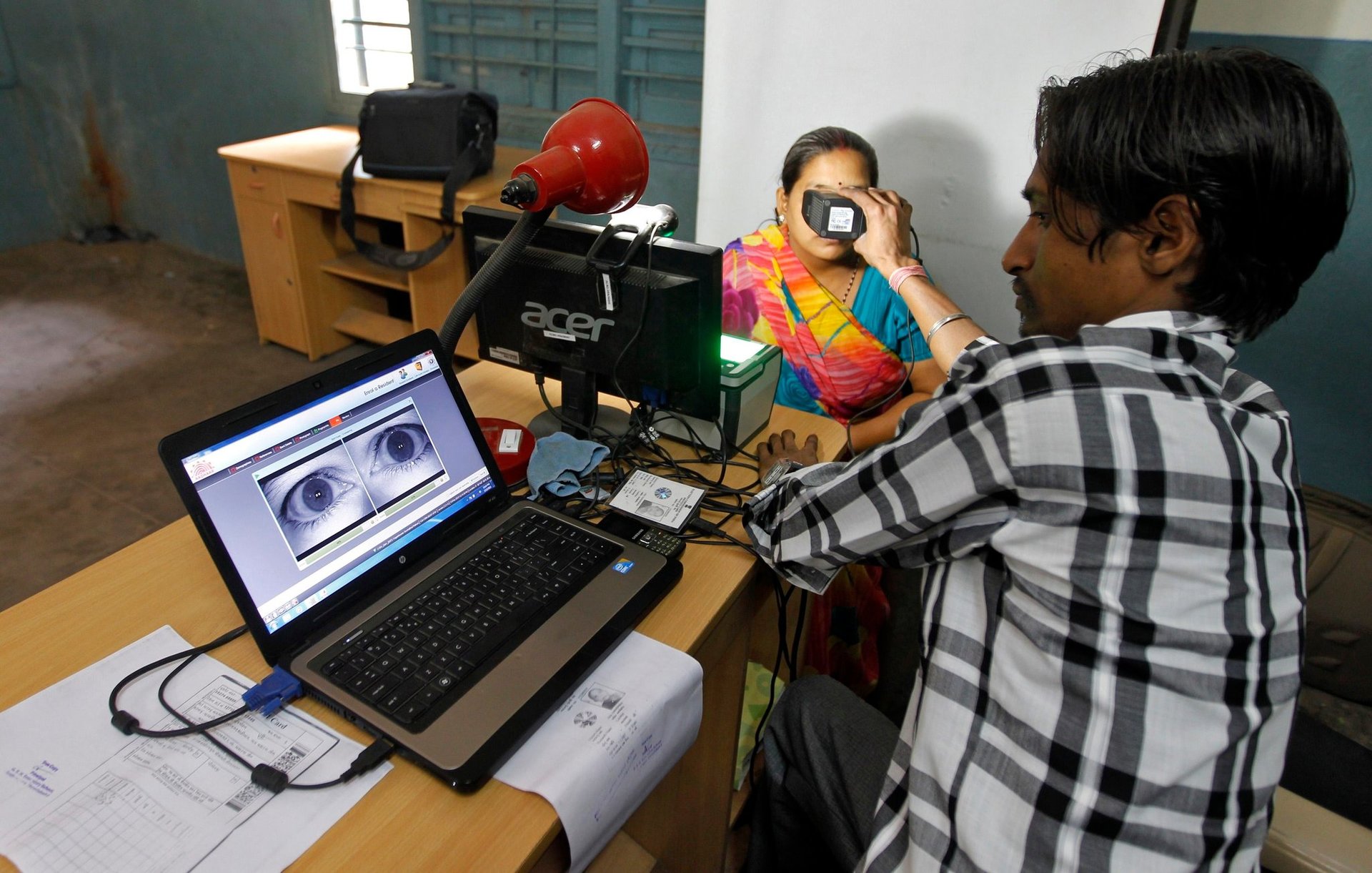
An entry in AADHAAR is available to all residents of India, this is an identification number that is linked to user biometric data. It is used in financial transactions, when working with various public and private services. AADHAAR is also linked to a cloud service for storing scanned documents.
Of course, not only India introduces biometric identification. Other states are also doing this. And not only the state, but also private companies. According to J'son & Partners Consulting, the global market for biometric systems will reach $ 40 billion by 2022. Analysts' conclusions are based on key player revenue figures by segment, taking into account hardware, software and integration.
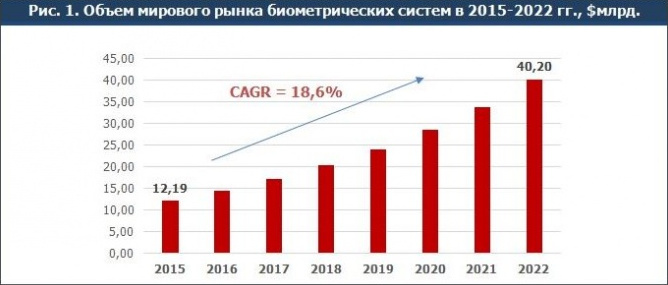
Another analytical agency, Acuity Research, estimates an increase in the number of e-ID biometric electronic documents to 749 million by 2018. And in total, according to agency experts, in 2018 there will be about 3.5 billion electronic documents in the world. Already, more than half of the UN member countries issue biometric passports. An example of the implementation of programs for the transition to biometric electronic documents is the government and private contracts of Canada, the USA, Belarus, Ukraine, Moldova, Lithuania, Hungary, Bangladesh, Senegal and other countries.
And what about Russia?
In Russia, biometric technologies are developing quite rapidly, more actively than in many countries. For example, the largest banks in the Russian Federation began testing biometric customer identification systems this year. Creates its database of biometric data of the Central Bank, the Ministry of Communications and Rosfinmonitoring, this system will reach the testing stage this year.
According to the Deputy Chairman of the Central Bank Olga Skorobogatova, the pilot project will make it possible to become a client of any bank remotely. To do this, it will be enough to go through the biometric registration procedure once at any credit institution participating in the project.
“Biometrics is connected with a very exciting topic. This is identification, remote identification, the creation of a single database of individuals, I’m talking more about individuals, which would allow any bank and any organization not to force customers to come with their feet to fill out a large list of documents, ”RIA quotes Skorobogatova.
Literally one step remains from this experiment to the creation of a national biometric database.

In the banking sector, they are trying to introduce customer identification systems by voice, photo, and fingerprints. For example, VTB24 has already tested the biometric identification in the framework of Internet banking. In the process of entering the online banking application, customers were asked to provide their photo and voice sample. Using this data, it is planned to carry out identification. After confirmation of the user's identity, all operations are performed without additional confirmation. Sberbank, which has already accredited RecFaces (application by Comlogic) as one of its partners in this area, is also showing great interest in biometrics.
Similar technologies are used in Promsvyazbank and Home Credit, Tinkoff Bank and several other organizations. As for the unified database of biometric data, the Central Bank, the Ministry of Telecommunications and Rosfinmonitoring are simultaneously working on its creation. The implementation of this project may take several years. The general database of biometric data, according to experts, will be useful for the financial and legal sectors, public services, public safety, medicine and more.
Digital Biometric Profile from RecFaces
Speaking about biometrics in Russia, one cannot fail to mention our development - an information platform for multimodal identification, called Id-Me.
Typically, companies that implement biometrics at home should choose several suppliers, invest heavily in creating a central computing infrastructure, its maintenance, various kinds of licenses and equipment.
But the matter is not only in the invested funds and the complexity of the process. Each algorithm that is currently offered on the market has a number of its features and advantages. We at RecFaces focused specifically on creating a full-fledged integrated platform that uses the best world achievements in the field of biometrics. Having the opportunity to study algorithms and compare them, we select those solutions that show maximum efficiency.
So, for example, biometric identification technology using a mathematical model of the face is licensed from the Japanese company Toshiba. 3D authentication is done using Artec ID and Intel solutions. There is no doubt that RecFaces will choose the most modern and promising technical solutions for those preparing to introduce Id-Me platform identification modules according to the iris pattern, fingerprints, palm vein pattern. Clients will only have to use the “magic” of Id-Me to solve their applied problems.
For an external observer, Id-Me works quite simply. One of the main components of the system is the Id-Box (capture module). It is a small “smart” identification device based on a PC platform in a compact package. It is this element that is responsible for recognizing faces and, in the future, other types of biometric data. It connects to a surveillance camera and other sensors. The system receives an array of data from them, which is immediately converted into a specialized index, a mathematical model, which is sent to the cloud for comparison with the standard stored there. Due to working with indexes, the system is not demanding on the “width” of the Internet channel.
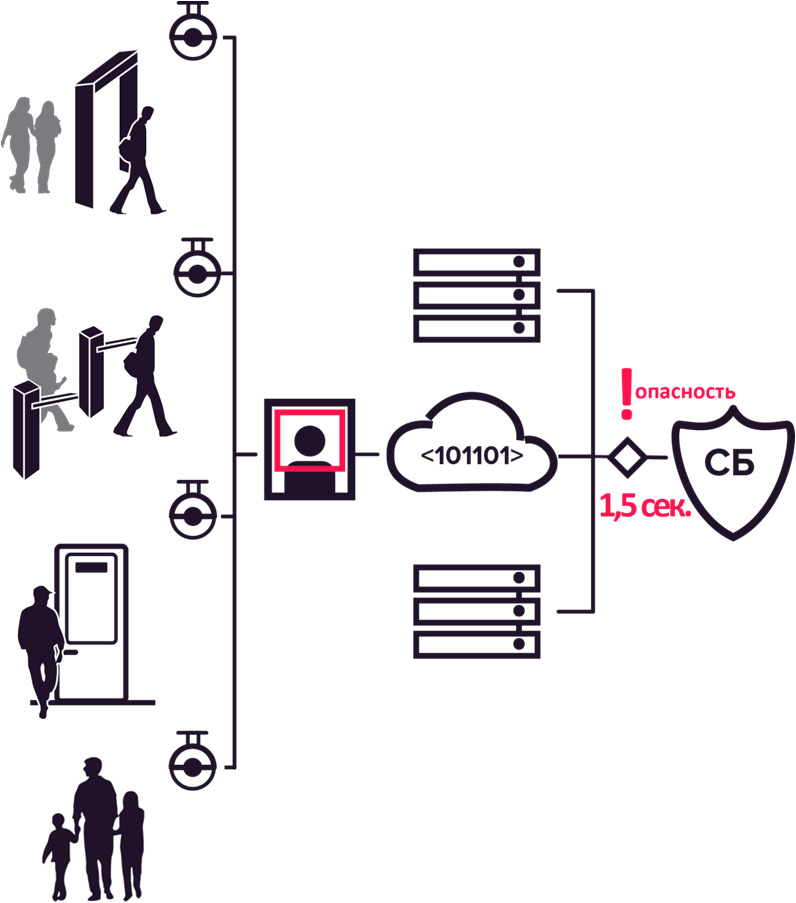
This is a universal system that works effectively with various types of images and can use information from a surveillance camera. Id-Box, if necessary, can collect statistics on the number of visitors, including age, gender and emotional state. If a failure occurs, you don’t need to worry, inside the box there is a large private hard drive where all the important data is stored. In the event of a sudden network outage, all information will be saved, and the system will continue to work.
The data collected by the Id-box is sent to the cloud, where the system compares the current index with all previous versions. If there is a match, that is, the system recognized the registered person, the client receives a notification. The service is compatible with major base platforms, including web-interface, mobile clients iOS, Android, Windows.
The whole system is well protected thanks to the encrypted connection. In addition, Firewall works, a crypto gateway with crypto routers is provided. Electronic digital signature, antivirus software and intrusion detection tools certified by FSTEC are used.
Scope of Id-Me
The RecFaces Id-Me biometric platform is designed to be most useful to banks, airports, retail, hospitality, sports organizations, and government agencies.
Banks can use biometrics to increase security. Here you can give as an example a possible case of a scammer trying to withdraw money from someone else's card. An ATM camera connected to Id-Me identifies the face of the person trying to do this. If this information does not coincide with that contained in the database, the withdrawal of funds is almost instantly blocked. To use this method of protection, you do not even need to equip the ATM with additional equipment.
Similarly, a bank can protect its credit department. A fraudster who is trying to carry out a financial transaction under a false name will not be able to do this if he is being watched by a camera connected to the Id-Me service.
Plus, bank employees can also log in, which is necessary when performing any critical tasks. This feature can come in handy in many areas. Id-Me, for example, allows you to automate the accounting of staff time.
Since Id-Me can analyze the video stream from surveillance cameras and individual images, the system can be used to collect statistics about visits, trajectories and behavior of visitors.
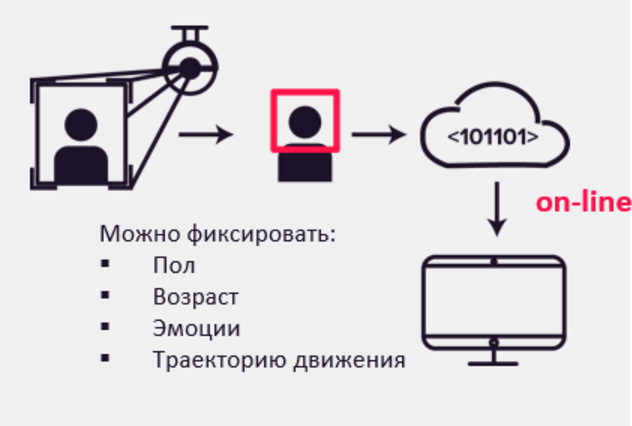
Using proprietary recognition technology from Toshiba and other partners, Id-Me allows you to use biometric identification in order to determine the gender, age of the buyer, to reveal his personal preferences, linking all this with CRM. Such a system is also excellent for recognizing an important customer by immediately receiving information about him, the date of his last visit to a store or other site. All this will help to find a common language with a person, instantly determining his preferences.
Already implemented together with RecFaces partners, examples of such a combination of biometric identification with CRM have shown their high marketing effectiveness. We will write about this later in detail.

It is imperative for the hotel industry to know its customers. If a person sees that they remember him, not only his first and last name, but also his preferences, then most likely such a client will return to the “attentive” hotel again and again. And for unwanted guests, you can create a "black list" with the corresponding data.
The hotel’s surveillance cameras will record everything that happens, notifying the administration if an unknown person has entered a room or office. Hotel employees will be aware that the smart system always knows who, where and why went, so there will be less abuse.
Organizers of sporting events, concerts, and other social events can promptly receive information about unwanted elements (for example, hooligan fans) trying to get to the event. Lost baby? The system will help you quickly determine how and when it happened, and also determine where the child is, if it is visible. Something went wrong? Security will be immediately warned.
It will be easier for law enforcement officers to maintain safety in schools or public places, at transport infrastructure facilities, if they receive notifications of suspicious people and events occurring in the observation area. Car thefts, hooligan antics - all this can be prevented if you learn about the problem in time.
In general, there are a lot of ways to use biometric systems. Behind them, no matter how pretentious it may sound, is the future. Biometrics is already in use and will be used in a large number of areas. And Id-Me can now be used in most of them. You can read more about what solutions the company is already offering and preparing to leave, to familiarize yourself with its comprehensive solutions by visiting the 23rd International Exhibition of Security Equipment and Equipment for Security and Fire Protection MIPS 2017 .
With this material, we are pleased to open the official RecFaces company blog on Habrahabr. Follow our activities in order to stay up to date with the latest achievements in the field of biometric identification, to get acquainted with examples of its implementation in various business sectors and public life. In the near future we will tell you about the possibilities of using biometric systems to increase the safety of transport infrastructure facilities, as well as analyze the case with the results of the actual implementation of Id-Me.
